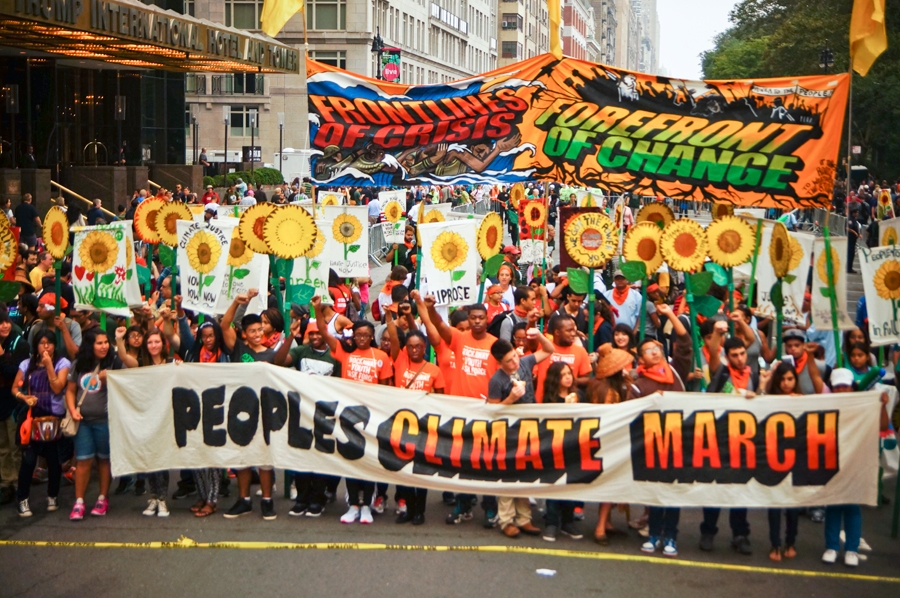I feel the need to write something here about money, art and climate change, because, on 21 September, a Sunday, hundreds of thousands of people from across the US and around the world gathered on Manhattan’s Upper West Side (where I live) to stage the People’s Climate March. Neither a protest action nor a pure celebration – though parts of it came off as both these things – the march was a kind of visibility test: move a large number of bodies (300,000+; more than hoped for) through a limited space (midtown Manhattan) to raise awareness about global anthropogenic climate change, or global warming.
Graphic designer Milton Glaser recently launched a campaign that puts this rather more bluntly, ‘It’s Not Warming, It’s Dying’ – that is, habitats and species throughout the globe are dying as a result of buildups of fossilfuel- generated greenhouse gases in the atmosphere, but also from the systematic polluting for which humans of the industrial age have become infamous. Glaser’s contribution, with its circular gradient running from green to black, was just one icon among the flurry of artfully produced banners and signs and floats and agitprop that was meant to draw attention to the climate-change cause and its various subgenres, all of which found their place on the streets of Manhattan and their voices – whistling, drumming, screaming – when, at 1pm that Sunday, it came time to ‘ring’ the collective alarm bell, loud enough, it was hoped, to be heard by the UN delegates and diplomats, just then in town for their own discussions on climate change (and other matters).
Money lacks imagination; it only wants to save itself
In this, I’d like to suggest that the Climate March was nothing if not a massive, collaborative work of performance art. Its purpose was atmospherics – pun intended – rather than demands. The march did not seek to take or hold space in order to conjure the genies of corporatist power (as did the #FloodWallStreet protest that followed on Monday). Its aims were reflexive rather than agonistic: ‘I see you, you see me; in seeing each other we affirm each other and raise each other up’, not, ‘I face you, you face me, we face each other down’. Thus the march sought what all works of art, indeed all subjects, seek, and that’s recognition.
Yet who would deny that money is the foremost medium of recognition today? It’s a big part of our fascination with artists such as Jeff Koons and Oscar Murillo, with the expansionist building campaigns of Tate and MoMA, with ‘power’ gallerists such as David Zwirner and Iwan Wirth – that is, after all, where the money is. And it’s why, following on the activism of US college students calling for their universities to divest from fossil fuel companies, Not an Alternative, an artist collective based in Brooklyn, has called for American museums – not just art museums, but science and natural-history museums too – to divest their endowments of fossil fuel stocks and to dissociate from the fossil fuel industry as well.
Now, there’s little evidence that divestment actually does much injury to companies financially. The ‘supermajors’ of the fossil fuel industry are among the biggest companies on the planet. ExxonMobil, for example, has a market capitalisation of around $400 billion, which as a measure of GDP would make it the 30th largest country in the world. To date, the publicly stated commitments to divest from fossil fuels on the part of foundations, universities, and civic and cultural institutions and leaders have come to $50bn in total, which is impressive but not threatening. Most of the biggest pension funds, whose sizes rival Big Oil, haven’t joined in, their reason being that it is better to keep a seat at the table. Divestment is largely a symbolic act, another work of atmospherics.
More encouraging than the divestment movement though has been the carbon-pricing movement. Here more than 300 institutional investors managing assets in the tens of trillions have called for carbon taxes and an end to subsidies to the fossil fuel industries. That would be financially injurious (just look how hard their lobbyists in Washington fight the prospect). It would also be redistributive, shifting the global economic picture from resource extraction (aka primitive accumulation) towards something more sustainable. Money, as they say, talks.
What that ‘something’ really looks like though is a job for a new contemporary avant-garde. Money lacks imagination; it only wants to save itself. Our popular and mass culture is obsessed with and saturated by stale apocalyptic visions and adolescent fantasies, and much of our so-called ‘advanced’ contemporary art is in thrall to a similar market solipsism. Just like the supermajors, its ‘explorations’ can be technically advanced and audacious in scope and expense, but they are carried out in a state of self-serving and cowardly denial of the world outside of the artworld.
Contemporary art could do worse than to take a lesson from the People’s Climate March. It needs to harness the power of a new atmospherics, a recognitive atmospherics that raises up our future rather than faces it down.
This article was first published in the November 2014 issue.
